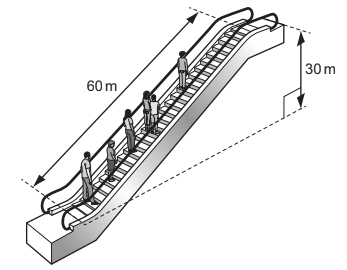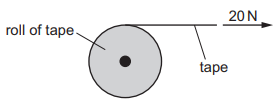Question
An escalator is 60 m long and lifts passengers through a vertical height of 30 m, as shown.

To drive the escalator against the forces of friction when there are no passengers requires a power of 2.0 kW.
The escalator is used by passengers of average mass 60 kg and the power to overcome friction remains constant.
How much power is required to drive the escalator when it is carrying 20 passengers and is travelling at 0.75 m s–1?
A \(4.4\) kW B \(6.4\) kW C \(8.8\) kW D \(10.8\) kW
Answer/Explanation
Ans: B
The work done in moving the passengers to the top is given as,
\(W = Nmgh\)
\( W = 20\times 60\times 9.8\times 30 = 352800 J \)
The power required is
\(P = W/t = W/(d/v)\)
\(P = 352800\times 0.75/60\)
\(P = 4400 W\)
The total power is therefore given as,
\(P_T = 4400 + 2000 = 64000 W = 6.4 kW \)
Question
Which statement about energy is not correct?
A Energy is never lost but it may be transferred between different forms.
B In an inelastic collision, the total energy is constant.
C The efficiency of a system is the ratio of the useful energy output to the total energy input.
D When a machine does work, friction reduces the total energy.
Answer/Explanation
Ans:D
A True : Energy is never lost but it may be transferred between different forms.Energy is neither created nor destroyed, hence the statement is correct.
B True : In an inelastic collision, the total energy is constant. In an inelastic collision, the momentum and energy are always conserved. Hence the statement is correct.
C True : The efficiency of a system is the ratio of the useful energy output to the total energy input. The statement is correct.
D False : When a machine does work, the energy is changed in the form of work and it the friction that does not reduces the total energy.
Question
A car of mass 1500 kg accelerates from an initial speed of 15 m s–1. This acceleration causes the car to gain 3.0 × 105 J of kinetic energy. What is the change in the speed of the car?
A 5.4 m s–1 B 10 m s–1 C 20 m s–1 D 25 m s–1
Answer/Explanation
Ans :B
The change in kinetic energy is given as,
\(\Delta KE = \frac{1}{2}m(v_f^2 – v_i^2)\)
\(3\times 10^5 = \frac{1}{2}\times 1500 (v_f^2 – 15^2)\)
\(v_f^2 = 400 + 15^2 \)
\( v_f^2 = 625\)
\(v_f = 25 m/s \)
Hence the option (D) is the right answer.
Question
A rocket is fired upwards.
As it accelerates upwards after leaving the launch pad, which forms of energy are changing?
A chemical energy, gravitational potential energy and kinetic energy
B chemical energy and gravitational potential energy only
C chemical energy and kinetic energy only
D gravitational potential energy and kinetic energy only
Answer/Explanation
Ans:
A
Question
A roll of tape of length 50 m requires a constant force of 20 N to unwrap it.

What is the work done in unwrapping the whole roll?
A 0.4 J B 2.5 J C 500 J D 1000 J
Answer/Explanation
Ans:
D
The amount of work done required to unwrap the whole roll is given as,
/(W = F d \)
\(W = 20\times 50 = 1000 J \)
